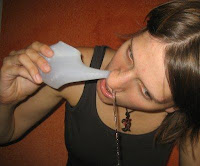Yoga gives as much importance to certain body cleansing processes or Dhautis as it does to Asanas, Sutras, Mudras or Pranayama. Without regular cleansing of the body system you will not gain maximum benefits from yoga practices and the body will not be ready for the higher practices of yoga.
Body cleansing is gained through the practice of Shat Karmas or the six purification techniques or Dhautis. They are very important for physical and mental health, and these simple techniques are also highly effective in healing internal disorders and diseases. These are also called Shat Kriyas or simply Kriyas.
These six main groups of Shat Karmas are as follows:
NETI: Nasal cleansing which include Jala Neti and Sutra Neti.
DHAUTI: Cleansing of the digestive tract including Danta Dhauti, Vatsara Dhauti etc.
NAULI: Abdominal massage.
BASTI: Colon cleansing.
KAPALABHATI: Purification and vitalization of the frontal lobes.
TRATAKA: Clearing of the mind through blink less gazing.
Each of these groups contains more than one practices such as Asjala Neti, Vaman Dhauti or
Kunjal Kriya, Moola Shodhana etc. which are all excellent practices designed to purify the whole body and bring about first class health. They also bring clarity and harmony to the mind. But all these should be tried with utmost care and only under the supervision of an expert yogi.
These Kriyas are not taught or even referred to in most schools of yoga for several reasons. Firstly these practices are very difficult, sometimes revolting and unnatural. Many teachers do not know or do these practices themselves. Teaching these practices is also not very easy. There is always risk of harm to the student if something goes wrong. Keeping all this in mind, most yoga teachers conveniently overlook these practices. However, it cannot be forgotten that these practices are a part of yoga. In fact these are mentioned as pre-requisites for Asanas, Mudras and Pranayama. It is believed that these practices cleanse the body and prepare it for practice of yoga. It is as if you are cleaning up your house first before re-decorating it. Surely you will not bother beautifying a dirty house. Cleanliness comes first and hence the importance of Kriyas or Sutras.
But again be VERY careful otherwise you may hurt or do SERIOUS DAMAGE to yourself from an improperly done Kriya especially Dhauti Kriya. Please do not try to learn them from merely a book or try them out after reading instructions on a web site. My suggestion is to have a look at these Kriyas. If you feel like it, TRY UNDER THE GUIDANCE OF AN EXPERT TEACHER. Good news however is that three of these Shat Karmas are comparatively safer to start practicing on your own i. e. Jala Neti, Kapalabhati and Trataka.





